没时间介绍了,废话不说先上车

以下所有扯淡都是建立在.NETCore2.0环境已经搭建好
右键解决方案>新建项目>
选择Web>ASP.NETCoreWeb应用程序(.NET Core)
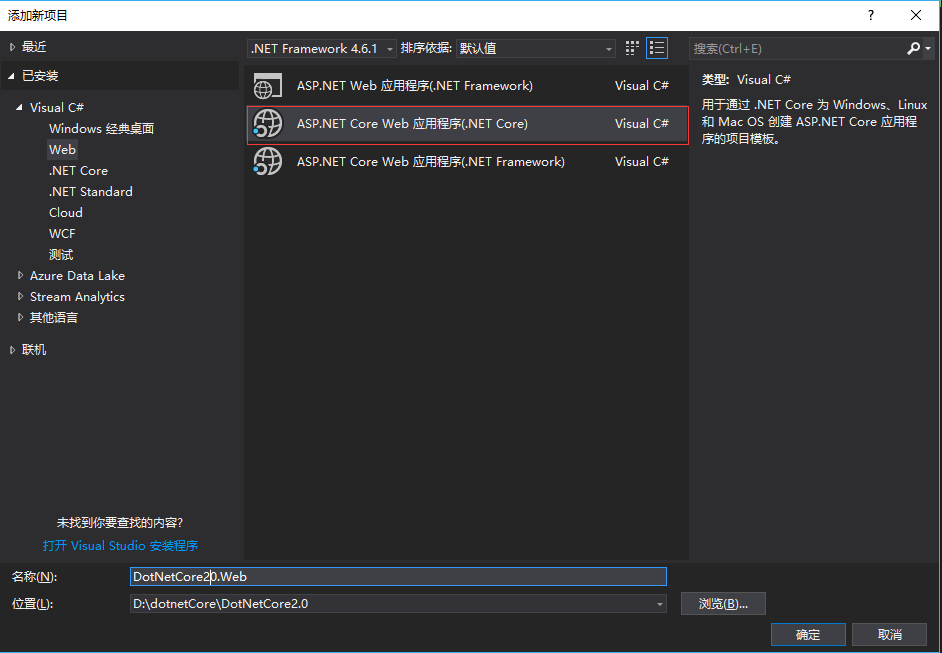
选择Web应用程序,暂时不选择启用Docker,身份验证选择个人用户账户(会自动生成一系列和用户认证的代码)
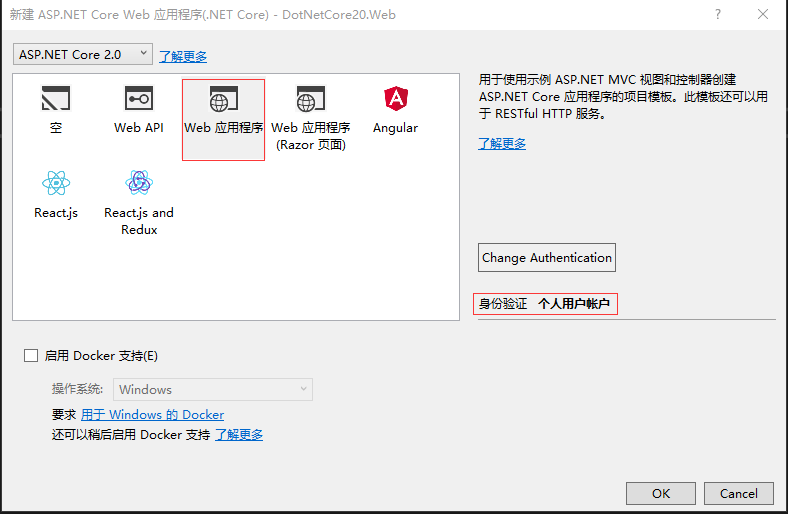
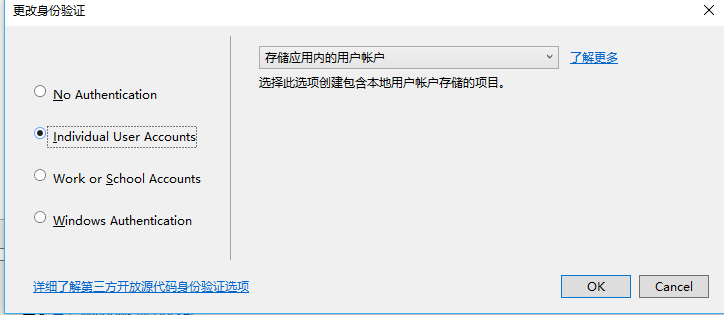
随后生代码层次目录如下:

其中会包含身份信息的相关实现,比如相关实体信息(user)之类的,如果想对扩展微软自动的生成的用户实体类,可在Models中的ApplicationUser下扩展,
在此ApplicationUser中添加属性即可:比如添加叫WeChatId属性,添加后如下:
using System; using System.Collections.Generic; using System.Linq; using System.Threading.Tasks; using Microsoft.AspNetCore.Identity; namespace DotNetCore20.Web.Models { // Add profile data for application users by adding properties to the ApplicationUser class public class ApplicationUser : IdentityUser { /// <summary> /// 微信Id /// </summary> public string WeChatId { get; set; } } }
在之后生成运行并迁移,数据库的AspNetUsers中就会多出WeChatId 属性.
一:安装引用
nugnet恢复引用失效时,可在程序包管理控制台输入:
dotnet restore 即可
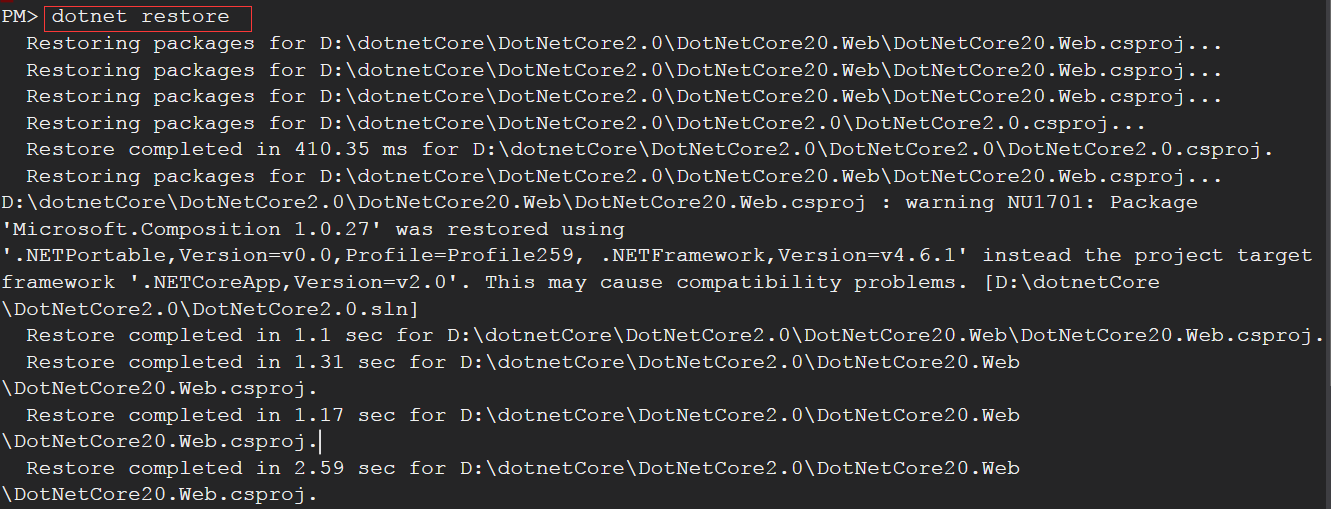
会发现在恢复指令后在NuGet中会有一个Microsoft.VisualStudio.Web.CodeGeneration.Design的报错,信息如下:
已使用“.NETPortable,Version=v0.0,Profile=Profile259, .NETFramework,Version=v4.6.1”而不是项目目标框架“.NETCoreApp,Version=v2.0”还原了包“Microsoft.Composition 1.0.27”。这可能会导致兼容性问题
这个库是ASP.NET Core的代码生成工具。包含用于生成控制器和视图的dotnet-aspnet-codegenerator命令,暂时可先卸载,不影响项目运行.
对项目类库的引用有以下几种方式
1.Nuget去安装(官网https://www.nuget.org/packages/)
2.右键依赖项点击菜单中的添加引用
3.可在程序包管理控制台输入:Install-Package 引用类库名称
4.可右键编辑csproj工程文件进行添加,然后执行dotnet restore
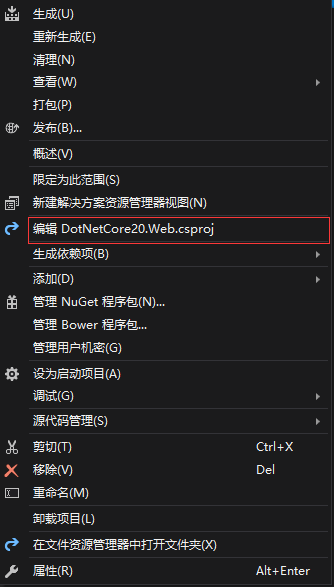
二.创建实体程序集
右键解决方案>添加项目>
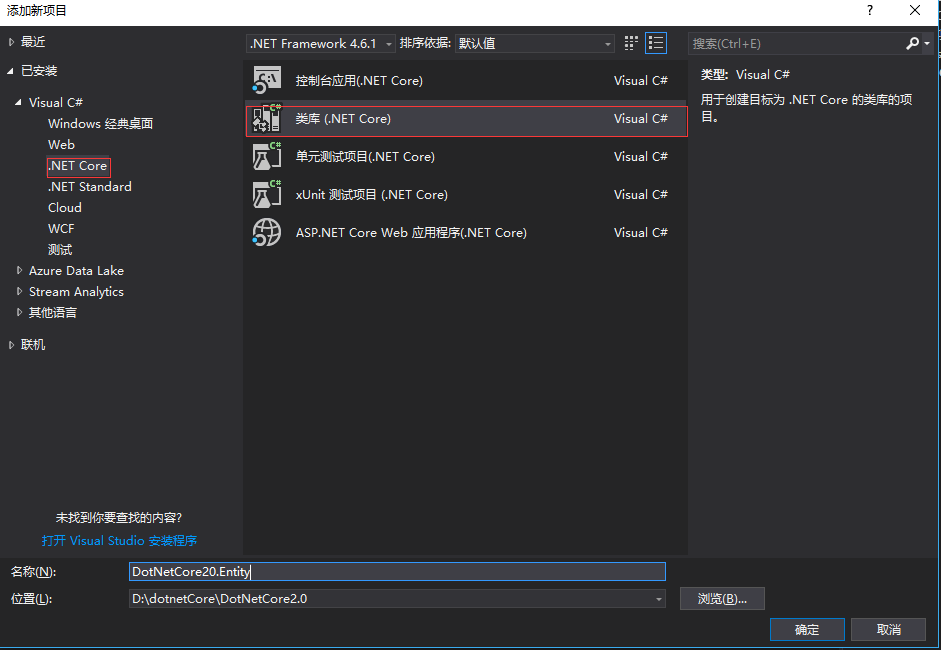
首先创建抽象类,供Entity实体继承,主要为每个实体提供公用属性
using System; using System.Collections.Generic; using System.ComponentModel.DataAnnotations; using System.Runtime.Serialization; using System.Text; namespace DotNetCore20.Entity.Core { /// <summary> /// DB表基底 /// </summary> [Serializable] public abstract partial class BaseEntity { /// <summary> /// Id /// </summary> [DataMember] public long Id { get; set; } /// <summary> /// DB 資料版號 /// </summary> [Timestamp] public byte[] RowVersion { get; set; } /// <summary> /// 创建时间 /// </summary> [DataMember] public DateTime CreateTime { get; set; } /// <summary> /// 更新时间 /// </summary> [DataMember] public DateTime UpdateTime { get; set; } /// <summary> /// 状态 /// </summary> [DataMember] public EnumState State { get; set; } } /// <summary> /// 状态 /// </summary> public enum EnumState { /// <summary> /// 删除 /// </summary> Delete = 1, /// <summary> /// 正常 /// </summary> Normal = 0, } }
添加一个UserExtend用户扩展类(Entity):
using DotNetCore20.Entity.Core; using System; using System.Runtime.Serialization; namespace DotNetCore20.Entity { [DataContract] public class UserExtend : BaseEntity { /// <summary> /// 用户Id /// </summary> [DataMember] public long UserId { get; set; } /// <summary> /// 昵称 /// </summary> [DataMember] public long NickName { get; set; } } }
三.创建数据层
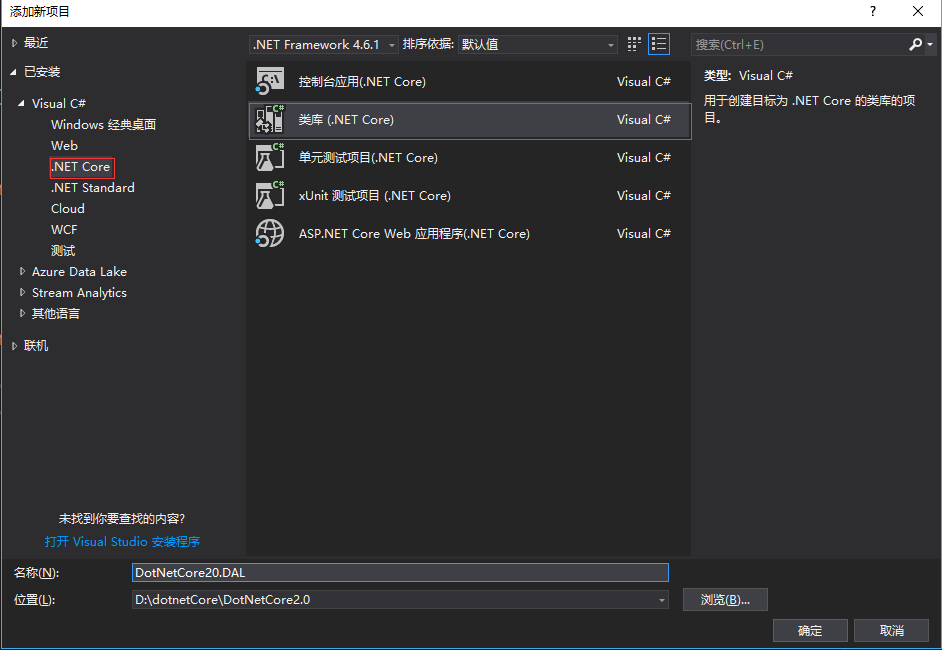
添加引用
DAL层需要用到EF实体映射相关和我们自己前面定义的Entity中的UserExtend实体表,所以要添加相关引用,DotNetCore20.Entity和 Microsoft.EntityFrameworkCore.Tools
快捷键:Ctrl+Alt+o 打开程序包管理器输入以下:
install-package Microsoft.EntityFrameworkCore.Tools

如果是网络限制下载失败,推荐把nuget镜像改为博客园资源,方法如下:
右键解决方案>管理解决方案的nuget程序包.显示如下:

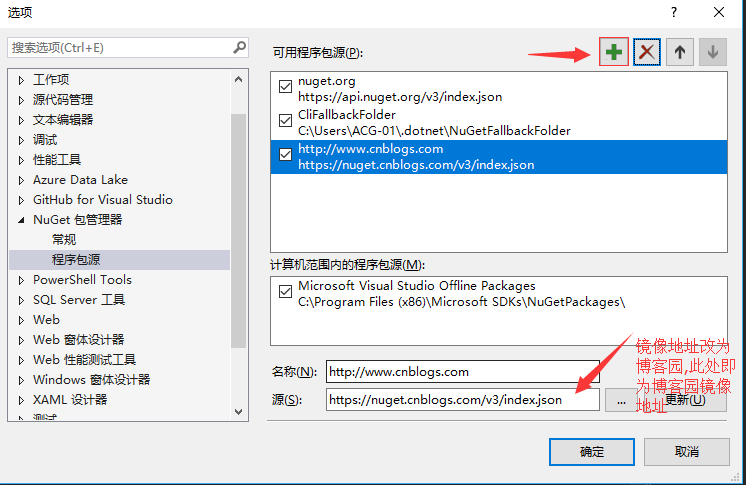
新建一个数据上下文类,目录结构如下:
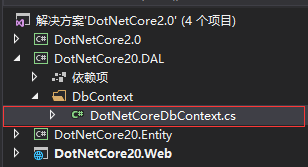
DotNetCoreDbContext内部代码改为以下:
using DotNetCore20.Entity; using Microsoft.EntityFrameworkCore; namespace DotNetCore20.DAL.DbContext { public class DotNetCoreDbContext : Microsoft.EntityFrameworkCore.DbContext { public DotNetCoreDbContext(DbContextOptions<DotNetCoreDbContext> options) : base(options) { } public DbSet<UserExtend> UserExtend { get; set; } } }
在此基本的实体映射相关的代码都完毕,现在还有一步,就是数据库连接字符串的配置
首先打开appsettings.json文件,在ConnectionStrings节点下增加以下
"DotNetCoreConnection": "Server=(localdb)\mssqllocaldb;Database=DotNetCoreDb;Trusted_Connection=True;MultipleActiveResultSets=true"
增加后如下:
{ "ConnectionStrings": { "DefaultConnection": "Server=(localdb)\mssqllocaldb;Database=DotNetCoreDefaultDb;Trusted_Connection=True;MultipleActiveResultSets=true", "DotNetCoreConnection": "Server=(localdb)\mssqllocaldb;Database=DotNetCoreDb;Trusted_Connection=True;MultipleActiveResultSets=true" }, "Logging": { "IncludeScopes": false, "Debug": { "LogLevel": { "Default": "Warning" } }, "Console": { "LogLevel": { "Default": "Warning" } } } }
再打开web网站下的Startup文件,在ConfigureServices方法中添加一下行:
//自定义数据库连接字符串 services.AddDbContext<DotNetCoreDbContext>(options => options.UseSqlServer(Configuration.GetConnectionString("DotNetCoreConnection")));
增加后如下:
using System; using System.Collections.Generic; using System.Linq; using System.Threading.Tasks; using Microsoft.AspNetCore.Builder; using Microsoft.AspNetCore.Diagnostics.EntityFrameworkCore; using Microsoft.AspNetCore.Identity; using Microsoft.AspNetCore.Http; using Microsoft.EntityFrameworkCore; using Microsoft.AspNetCore.Hosting; using Microsoft.Extensions.Configuration; using Microsoft.Extensions.DependencyInjection; using Microsoft.Extensions.Options; using DotNetCore20.Web.Data; using DotNetCore20.Web.Models; using DotNetCore20.Web.Services; using DotNetCore20.DAL.DbContext; namespace DotNetCore20.Web { public class Startup { public Startup(IConfiguration configuration) { Configuration = configuration; } public IConfiguration Configuration { get; } // This method gets called by the runtime. Use this method to add services to the container. public void ConfigureServices(IServiceCollection services) { services.AddDbContext<ApplicationDbContext>(options => options.UseSqlServer(Configuration.GetConnectionString("DefaultConnection"))); //自定义数据库连接字符串 services.AddDbContext<DotNetCoreDbContext>(options => options.UseSqlServer(Configuration.GetConnectionString("DotNetCoreConnection"))); services.AddIdentity<ApplicationUser, IdentityRole>() .AddEntityFrameworkStores<ApplicationDbContext>() .AddDefaultTokenProviders(); // Add application services. services.AddTransient<IEmailSender, AuthMessageSender>(); services.AddTransient<ISmsSender, AuthMessageSender>(); services.AddMvc(); } // This method gets called by the runtime. Use this method to configure the HTTP request pipeline. public void Configure(IApplicationBuilder app, IHostingEnvironment env) { if (env.IsDevelopment()) { app.UseDeveloperExceptionPage(); app.UseBrowserLink(); app.UseDatabaseErrorPage(); } else { app.UseExceptionHandler("/Home/Error"); } app.UseStaticFiles(); app.UseAuthentication(); app.UseMvc(routes => { routes.MapRoute( name: "default", template: "{controller=Home}/{action=Index}/{id?}"); }); } } }
运行程序,点击登陆(只要访问数据库的操作都可),出现错误页面:
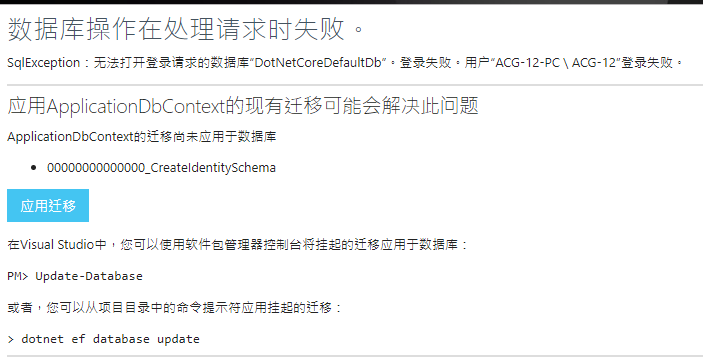
点击应用迁移 ,即自动迁移数据库.
,即自动迁移数据库.
由于两个数据库,只会自动迁移关于用户的表AspNetUsers,
所以还得VS中程序包管理器中下命令迁移.
Add-Migration firstMigration -Context DotNetCoreDbContext
以上命令执行后再执行以下命令:
Update-Database -Context DotNetCoreDbContext;
然后查看数据库会发现多出两个数据库,
以DotNetCoreDefaultDb生成的为例,会生成如下表:

其中AspNetUsers就中会有之前添加的WeChatId字段

然后再次运行程序:

这样一个完整的 Asp.NetCore2.0网站就初步运行起来了
下一篇将在DAL层增加Repository和UnitWorks,完成简单crud的统一管理